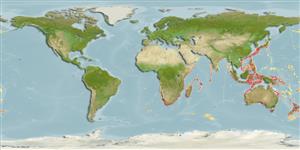Common names from other countries
Environment: milieu / climate zone / depth range / distribution range
पारिस्थितिकी
समुद्री बाथीड़िमरसल; गहराई सीमा 90 - 435 m (Ref. 33352). Deep-water
Indo-West Pacific: South Africa to northwestern Australia; northward to South China Sea (Ref. 33352). Southeast Atlantic: southeast coast of South Africa (Ref. 4919). Mediterranean (Lessepsian migrant) (Ref. 96612).
आकार / वज़न / Age
Maturity: Lm ? range ? - ? cm
Max length : 12.0 cm TL पुल्लिंग / अलिंग; (Ref. 4919)
पृष्ठीय रीढ़ (सम्पूर्ण) : 0; पृष्ठीय सौफट रेज़ (सम्पूर्ण) : 8 - 9; गुदा कांटा: 0; ऐनल सौफट रेज़: 6 - 7. Grey with a dark blotch above and behind eye and at base of dorsal fin; rear margin of caudal fin black; black specks on belly (Ref. 4919).
Minimum depth reported taken from Ref. 127989.
Life cycle and mating behavior
Maturities | पुनरुत्पत्ति | Spawnings | Egg(s) | Fecundities | लार्वा
Leis, J.M., 1986. Diodontidae. p. 903-907. In M.M. Smith and P.C. Heemstra (eds.) Smiths' sea fishes. Springer-Verlag, Berlin. (Ref. 4423)
IUCN Red List Status (Ref. 130435)
CITES (Ref. 128078)
Not Evaluated
Threat to humans
Harmless
Human uses
साधन
Special reports
Download XML
इंटरनेट स्रोत
Estimates based on models
Preferred temperature (Ref.
115969): 9 - 16.8, mean 12 (based on 156 cells).
Phylogenetic diversity index (Ref.
82804): PD
50 = 1.0000 [Uniqueness, from 0.5 = low to 2.0 = high].
Bayesian length-weight: a=0.02570 (0.01193 - 0.05536), b=2.88 (2.71 - 3.05), in cm Total Length, based on LWR estimates for this (Sub)family-body shape (Ref.
93245).
Trophic level (Ref.
69278): 3.3 ±0.2 se; based on size and trophs of closest relatives
लौटाव (Ref.
120179): ऊंचा, न्यूनतम जनसंख्या दुगनी समय अवलागत 15 महीने। (Preliminary K or Fecundity.).
Fishing Vulnerability (Ref.
59153): Low vulnerability (10 of 100).
